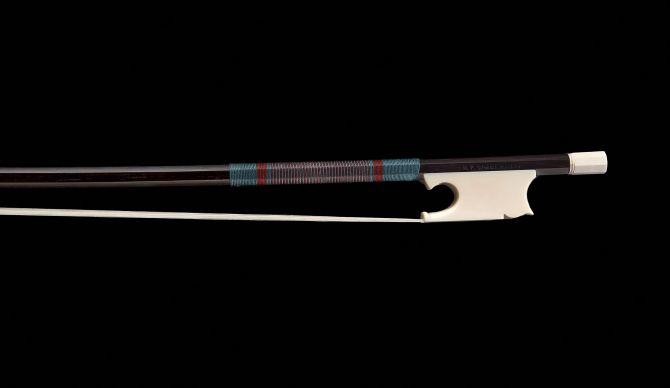Violin Bow Pearl and Ebony Slide Liners

Violin, Cello & Bass Bow Parts: Shell Slides and dots along with imitation opal slides and ebony slide liners.
About our shell:
All shell products are legally imported to us from legitimate and recognized sources. All US permits are utilized when importing - there are three different US Import permits required for each shipment.
We offer violin bow shell slides and dots in Awabi Pearl, Green Rippled Abalone and Mother of Pearl.
Our Mother of Pearl shell is a specially sourced form of MOP from the Philippines where the shell is spun, by nature, with layers of highly iridescent white pearl and an occasional ultra thin layer of golden color pearl. The golden micro-layers are not seen as gold directly to the eye but this feature gives the MOP from this shell a particular brilliance and light catching quality not seen in other MOP shell.
This feature of color and iridescence is only found in the Philippine shell. This is not your average Mother of Pearl.
About our imitation opal:
This is truly a great material. Incredible beauty and indefinite lifespan. Read more about this material on our opal page.
As a brief guide to the historical use of pearl in bows:
The French Peccatte school would have, for the most part, been using the Ormeau. This is a member of the Haliotis family that lives off of the coast of North-Western France. It often has a small, tight flame that runs through the shell. It is a very small shell, making it difficult to get pieces long enough to make a slide. I believe that it was generally worked along the natural curve of the shell and then flattened. Its main value today is due to its historic use and would otherwise be considered too marginal.
The Pajoet school around the same time was using the green abalone from what is now Baja and Southern California. They favored the piece from the inside and around the muscled scar—i.e. the heart—of the shell.
Viorin to modern day French use, for the most part, the Awabi shell from Japan. Japan was reopened to Western trade in 1853.
The English... such as the Hills were, for the most part, using White Mother of Pearl for their standard bows. I assume this shell came from Australia due to their relations to the ex-pat felons living there. However, in fancy, Gold-mounted bows made by such makers as Tubbs you will sometimes see the "heart" of the black abalone.
The Germans... In their early bows were using, I believe, fresh water shells. Makers such as Bausch would, at some times, use Green ab heart. In most of the 20th century their silver-mounted bows were fitted with very high quality green flamed abalone with most shifting to awabi in the latter part of the 20th century to the present day.
The American School... Is too promiscuous for the space and time available.
All of the ebony utilized in this product is Diospyros crassiflora. Its origin is Nigeria. We have imported this with all paperwork being filed electronically and doubled with paper form. All proper strict procedures have been adhered to including Lacey Act PPQ Form 505, US Fish & Wildlife Import/Export permits, and USDA Import and Health Requirement Permits and USDA Plant & Plant Product Declaration Forms in compliance with Lacey Act Requirements (16 USC 3372(f)). All products adhere to USDA APHIS-APIE standards and procedures.
View Categories
Imitation Opal Violin Slide & Eye StockAwabi Pearl Slides - Violin, Cello and Bass
Abalone Pearl Slides - Violin, Cello and Bass
MOP - Mother of Pearl Slides - Violin, Cello and Bass
Ormeaux Pearl Slide & Eye Stock
Awabi and Paua "Feathers" - Slide & Eye Stock
Ebony Veneer Slide Liners Violin, Cello & Bass
Awabi Pearl Dots for Inlay
Abalone Pearl Dots for Inlay
Mother of Pearl Dots for Inlay

